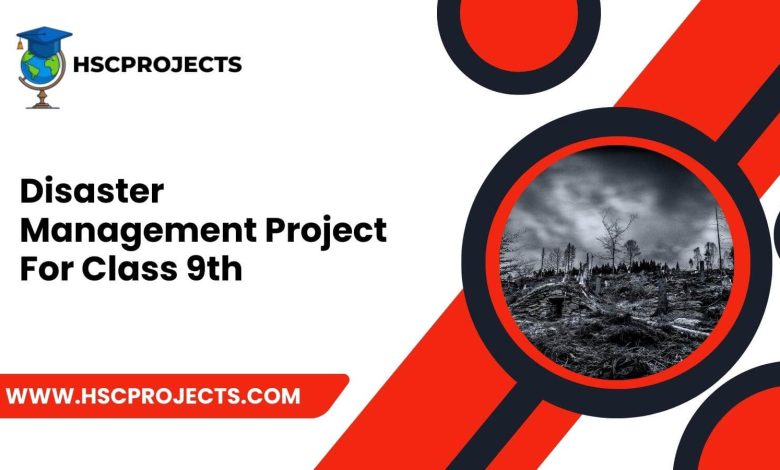
Disaster Management Project For Class 9th
Acknowledgment:
I extend my heartfelt appreciation to all those who’ve been pivotal in supporting me throughout the completion of this comprehensive project on disaster management.
First and foremost, I express profound gratitude to my Social Science professor for providing me with the invaluable opportunity to delve into this critical field of study. Your guidance and mentorship have been instrumental in expanding my comprehension of disaster management.
My sincere thanks also go to my parents, whose unwavering support and encouragement have been a constant source of motivation throughout this journey. Your counsel and assistance have played a pivotal role in my success in this endeavor.
Furthermore, I’d like to extend my appreciation to the numerous experts and researchers who’ve dedicated their lives to the study of disasters, particularly earthquakes. It is through their relentless efforts and dedication that I was able to gather the extensive background knowledge that formed the foundation of this project.
Last but not least, I want to express my gratitude to all those individuals whose contributions, regardless of their magnitude, were essential to the success of this project. Your collective efforts have enriched the project and contributed to its overall effectiveness.
This project would not have been possible without the support, guidance, and collaboration of these individuals, and for that, I am profoundly grateful.
Introduction to Disaster Management:
Disaster management represents a comprehensive approach aimed at mitigating the impact of disasters on individuals, communities, and the environment. It encompasses a broad spectrum of activities and strategies focused on minimizing the effects of natural or human-made disasters and ensuring a coordinated response when these events occur.
Key Components of Disaster Management:
- Mitigation: Mitigation efforts concentrate on reducing the risk of disasters before they occur. This encompasses measures such as enforcing robust building codes to ensure structures can withstand earthquakes or floods, implementing prudent land-use planning to avoid construction in high-risk areas, and conducting public education campaigns to raise awareness about disaster preparedness.
- Preparedness: Preparedness involves meticulous planning and readiness for potential disasters. Communities and individuals develop emergency response plans, assemble emergency kits, and undergo training to understand how to respond when disaster strikes. Early warning systems are established to provide timely information and alerts.
- Response: Response is the immediate action taken during and after a disaster. It entails mobilizing first responders, including firefighters and medical teams, executing search and rescue operations, delivering emergency medical care, and ensuring the safety of affected individuals. Coordination among government agencies, non-governmental organizations, and the private sector is imperative during this phase.
- Recovery: After the immediate response phase, recovery efforts aim to restore normalcy and rebuild affected communities. This includes repairing infrastructure, providing psychological support to survivors, offering financial assistance to those affected, and addressing long-term health and environmental issues caused by the disaster.
The Significance of Disaster Management:
Disaster management holds immense importance for several reasons:
- Saving Lives: It is crucial for minimizing casualties during disasters. Early warning systems and well-practiced response plans can significantly reduce the loss of life.
- Reducing Damage: Effective mitigation measures can help prevent or reduce damage to infrastructure and property, ultimately saving billions of dollars in recovery costs.
- Community Resilience: Disaster management promotes community resilience by empowering individuals and communities to be prepared, self-reliant, and capable of responding effectively in times of crisis.
- Environmental Protection: Disaster management includes strategies for minimizing the environmental impact of disasters, such as oil spills or chemical accidents.
Types of Disasters:
Disasters can be broadly categorized into two main types: natural disasters and human-made disasters. These events can cause significant harm to people, property, and the environment. Understanding these different types of disasters is crucial for effective disaster management and preparedness.
Natural Disasters:
- Earthquakes: Earthquakes result from the sudden release of energy in the Earth’s crust, causing ground shaking and potentially leading to building collapses, landslides, and tsunamis in coastal regions.

- Floods: Flooding occurs when water overflows onto normally dry land due to heavy rainfall, snowmelt, dam failures, or storm surges during hurricanes, causing extensive damage to homes, infrastructure, and agriculture.

- Hurricanes/Cyclones/Typhoons: These powerful tropical storms characterized by strong winds and heavy rainfall can cause widespread devastation, including wind damage, storm surges, and flooding.

- Tornadoes: Violent windstorms characterized by a twisting, funnel-shaped cloud can result in extreme destruction, including leveled homes and buildings.

- Wildfires: Uncontrolled fires that spread rapidly through vegetation, often in dry, hot conditions, can lead to the destruction of forests, homes, and communities.

- Droughts: Prolonged periods of abnormally low precipitation causing water shortages with far-reaching effects on agriculture, water supplies, and ecosystems.

- Volcanic Eruptions: The release of molten rock, ash, and gases from volcanoes can lead to lava flows, ashfall, and even tsunamis in certain cases.

Human-Made Disasters:
- Industrial Accidents: These disasters result from accidents in industrial facilities, such as chemical spills, explosions, or nuclear incidents, causing environmental contamination and health hazards.
- Transportation Accidents: Including plane crashes, train derailments, shipwrecks, and vehicle accidents that often result in casualties and environmental damage.
- Terrorism: Deliberate attacks on civilian populations or infrastructure, creating fear and chaos through actions like bombings, chemical attacks, and cyberattacks.
- Oil Spills: Occur when large quantities of oil are released into the environment, often from tanker accidents or offshore drilling, with devastating effects on marine life and coastal ecosystems.
- Radiological Emergencies: Involve the release of radioactive materials from nuclear power plants, research facilities, or accidents, posing significant health risks requiring careful containment and cleanup.
- Cybersecurity Incidents: With increasing technology reliance, cybersecurity incidents, such as data breaches or cyberattacks on critical infrastructure, can disrupt essential services and compromise security.
Understanding Disaster Risk:
Comprehending disaster risk forms the bedrock of effective disaster management. It involves assessing and analyzing potential hazards and vulnerabilities to predict and mitigate the impact of disasters. A thorough understanding of disaster risk empowers individuals, communities, and governments to develop strategies that minimize harm and enhance resilience.
Key Aspects of Understanding Disaster Risk:
- Risk Assessment: Disaster risk assessment identifies and evaluates potential hazards a region or community may face, encompassing natural hazards like earthquakes, floods, and hurricanes, as well as human-made hazards like industrial accidents or terrorism.
- Vulnerability Analysis: Vulnerability analysis assesses the susceptibility of a population, infrastructure, and ecosystems to identified hazards, evaluating factors such as construction quality, healthcare systems, emergency response capabilities, and social factors that may increase vulnerability.
- Exposure Evaluation: Evaluating exposure entails determining what and who is at risk, including mapping hazard-prone areas, identifying critical infrastructure in harm’s way, and understanding the demographics of the affected population.
- Risk Communication: Effective communication of disaster risk to the public is essential, using clear language and accessible tools to convey potential threats and necessary actions. Public awareness campaigns and educational programs play a significant role in risk communication.
- Scenario Planning: Scenario planning involves creating hypothetical disaster scenarios based on identified risks, helping understand the potential consequences of various disaster scenarios and aiding in preparedness and response planning.
Benefits of Understanding Disaster Risk:
- Proactive Preparedness: In-depth knowledge of disaster risk enables communities and governments to proactively prepare for potential disasters, including developing emergency response plans, conducting drills, and stockpiling necessary resources.
- Resource Allocation: Understanding risk helps allocate resources more efficiently by identifying high-risk areas and vulnerable populations, directing resources where they are most needed.
- Resilience Building: Armed with knowledge of disaster risk, communities can implement resilience-building measures, including constructing more resilient infrastructure, improving healthcare facilities, and promoting sustainable land-use practices.
- Effective Response: When disaster strikes, understanding risk ensures a swift and effective response, enabling emergency responders to prioritize actions and allocate resources appropriately.
- Reducing Impact: Ultimately, the goal of understanding disaster risk is to reduce the impact of disasters, identifying and mitigating vulnerabilities to minimize casualties, damage, and long-term economic and environmental harm.
Disaster Preparedness:
Disaster preparedness represents a critical element of effective disaster management, encompassing a spectrum of activities, plans, and measures aimed at ensuring that individuals, communities, and governments are ready to respond to disasters when they occur. Preparedness is vital for minimizing the loss of life and property, as well as the overall impact of disasters.
Key Aspects of Disaster Preparedness:
- Emergency Response Plans: Preparedness begins with the development of emergency response plans that outline steps to be taken before, during, and after a disaster. These plans specify roles and responsibilities for various agencies and organizations involved in disaster response.
- Community Education: Public awareness and education campaigns are essential for preparedness, informing people about potential hazards, the importance of early warning systems, and the actions they should take during a disaster. This includes creating emergency kits, knowing evacuation routes, and having a family communication plan.
- Resource Stockpiling: Preparedness involves stockpiling essential resources such as food, water, medical supplies, and emergency equipment, critical for sustaining individuals and communities during the immediate aftermath of a disaster when access to outside help may be limited.
- Training and Drills: Regular training and drills help individuals and organizations practice their roles in disaster response, including first aid training, search and rescue exercises, and coordination drills among emergency responders.
- Early Warning Systems: Preparedness includes the establishment and maintenance of early warning systems that provide advance notice of potential disasters, allowing people to take protective actions. For example, tsunami warning systems can alert coastal communities of impending tsunamis.
- Infrastructure Resilience: Preparedness involves strengthening infrastructure to withstand disasters, including building codes ensuring structures are earthquake-resistant, flood defenses like levees and dams, and measures to protect critical infrastructure such as power plants and hospitals.
Benefits of Disaster Preparedness:
- Lives Saved: Effective preparedness measures can significantly reduce casualties by ensuring people know how to respond to disasters and have the necessary resources on hand.
- Reduced Damage: Preparedness measures such as building codes and infrastructure improvements can help reduce the physical damage caused by disasters, saving billions in recovery costs.
- Community Resilience: Communities that are well-prepared are more resilient and can recover more quickly after a disaster, reducing the long-term social and economic impacts of disasters.
- Efficient Response: Preparedness streamlines the response to disasters. When everyone knows their roles and responsibilities, and resources are readily available, response efforts are more efficient.
- Peace of Mind: Knowing that preparedness measures are in place can provide peace of mind to individuals and communities, reducing fear and anxiety during disasters.
Challenges in Disaster Management:
- Climate Change: Addressing the impacts of climate change, including more frequent and severe weather events, presents a critical challenge for disaster management.
- Population Growth and Urbanization: Rapid urbanization in many regions increases the vulnerability of densely populated areas to disasters, necessitating the inclusion of disaster resilience in urban planning.
- Technology Dependency: While technology can enhance disaster management, it also poses challenges, being vulnerable to cyberattacks or disruptions during disasters.
- Resource Limitations: Adequate resources, including funding, trained personnel, and equipment, are necessary for effective disaster management. Resource limitations can hinder response efforts.
- Complex Emergencies: Conflict and political instability can complicate disaster response efforts, especially in regions facing both natural and human-made disasters.
Solutions and Strategies:
- Climate Adaptation: Implementing climate adaptation strategies, such as resilient infrastructure and sustainable land-use planning, can help communities better withstand the impacts of climate change.
- Community Engagement: Empowering communities to be actively involved in disaster preparedness and response can improve resilience, utilizing local knowledge and participation.
- Data and Technology: Advances in data analytics, remote sensing, and artificial intelligence can enhance disaster risk assessment, early warning systems, and response coordination.
- Public-Private Partnerships: Collaborations between government agencies, non-profit organizations, and the private sector can provide additional resources and expertise for disaster management.
- Education and Training: Investing in education and training programs for emergency responders and the public is essential, ensuring individuals and organizations are well-prepared for disasters.
- International Cooperation: Disaster management often transcends national borders. Strengthening international cooperation and sharing best practices can improve response to cross-border disasters.
- Resilience Planning: Integrating resilience into urban planning and development is crucial, encompassing building codes, zoning regulations, and infrastructure design that consider disaster risk reduction.
- Innovation and Research: Encouraging innovation and research in disaster management can lead to new technologies and strategies that enhance preparedness and response efforts.
Certificate of Completion
I proudly certify that
[Your Full Name]has successfully completed the project on
“Disaster Management”
as part of my 9th-grade curriculum. This project has been a significant endeavor, covering various aspects of disaster management, including acknowledgment, understanding disaster risk, preparedness, and future challenges and solutions.
I want to express my gratitude to my teachers and mentors for their guidance and support throughout this project. Their wisdom and encouragement have been invaluable in helping me gain a deeper understanding of this critical field.
I also appreciate the unwavering support of my family, who have been there every step of the way, offering advice and encouragement when needed.
I embarked on this project with a thirst for knowledge, and I am proud of the effort and dedication I have invested in researching and presenting this material. This project reflects my commitment to learning and my passion for making our communities more resilient in the face of adversity.
Project Completion Date: [Date] [Your Full Name](Student’s Signature)
[School Name] [School Address] [City, State, ZIP Code]Date: [Date]
In order to download the PDF, You must follow on Youtube. Once done, Click on Submit
Follow On YoutubeSubscribed? Click on Confirm
Download Disaster Management Project For Class 9th PDF






